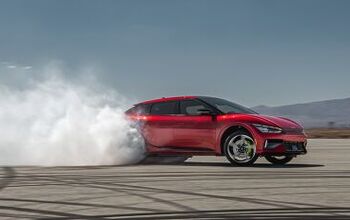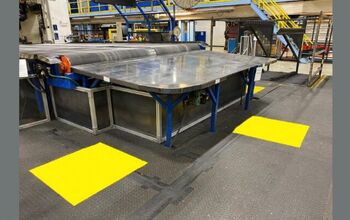Who Wants In On The 2013 Viper? Anyone? Bueller?
With a new Viper being readied for a 2012 auto show debut ahead of a 2013 launch, Automotive News [sub]’s Rick Kranz has discovered something of an issue in the development process: suppliers don’t want in.
Ralph Gilles, who heads Chrysler Group’s design organization and SRT, the automaker’s performance group, says many suppliers said “thanks, but no thanks” when the automaker knocked on their doors.
“It has been tough to get low-volume suppliers,” Gilles says. “We have had a few hiccups here and there as we get suppliers. That type of fringe business has really dwindled. A lot of people are looking for big accounts now, but now that is behind us.”
Kranz blames low volume (2,103 units in its best year, 392 units last year) and supplier consolidation for the “hiccups.” But as it so happens, this has been a recurring problem for the Viper since day one…
Today’s reading is from the First Book of Lutz (“Guts”), Part One, Chapter 3: “We Just Did It”: The Story of the Viper.
Our other problems concerned suppliers. The Viper program proved to be our first experiment in having suppliers do the core engineering for a new model’s components. Curiously, it wasn’t that tough a goal to reach for those suppliers who’d already agreed to sign on. Most of Chrysler’s suppliers had caught Viper fever and wanted to participate. (The fact that many of their CEOs lusted after having their own Viper probably didn’t hurt).
But some of our most trusted partners simply refused to join, contending that the low volume didn’t justify the effort. From a narrowly left-brained viewpoint, they were right. Had they engaged their whole brain, however, and considered the project’s total benefits, most, I suspect would have chosen differently. A German supplier whom we had asked to produce the Viper’s new six-speed transmission really let us down. When we were already well into the program (and when it seemed to late to change something as fundamental as the transmission) he told us the deal was off unless could cough up several million dollars not previously discussed (and not available in our budget).
What to do? Knuckle under to prevent delay? Or tell the supplier “Thank you; it’s been semi-nice working with you, but forget it”? Bravely, the team picked the latter course. Working quickly and creatively they found a excellent alternative in the all-new Borg-Warner T-6 transmission, which was then under development fir GM’s Camaro, Firebird and Corvette models. Viper remained on track, while the German transmission company won an empty victory: To achieve a trivial savings, they sacrificed their opportunity to become a supplier for Chrysler’s more mainstream products and, more importantly, the unquantifiable but undeniable luster they would have enjoyed from being associated with, perhaps, the most publicized car in modern times.
What’s the lesson? Bringing suppliers on board a low-volume project like Viper requires holding “more mainstream product” business over the suppliers head, but even more, relying on “Viper fever” to inspire suppliers to become part of the project. Lutz doesn’t just identify the “luster” from being associated with Viper, but even goes as far as to point out that suppliers may have participated simply because they wanted a Viper of their own. To Lutz, the product guy, this is simply testament to the visceral power of a highly emotional car. To the purchasing and supply chain managers, however, this emotional basis for a business deal is hardly a sustainable state of affairs. Not only does it have the potential to challenge the financial stability of supplier firms with already low margins, but it also makes the supply chain dependent on the hype generated by the vhicle.
And that seems to have been the problem this time around: though the new Viper will doubtless be an impressive machine, there is no way it could even hope to make the kind of splash that the original did. As a car, the Viper has improved with age… as an idea, however, the Viper is getting stale. Are there still supplier bosses who are participating in the project simply because they want a 2013 Viper of their own? Very possibly, but “Viper fever” as it existed back 1989 isn’t going to keep a low-volume project running. The implication of this supplier trouble: the new Viper could well become an even bigger money loser than before. After all, enthusiasm and industry have always been turbulent bed-mates.
More by Edward Niedermeyer
Latest Car Reviews
Read moreLatest Product Reviews
Read moreRecent Comments
- CKNSLS Sierra SLT Since they are the darling of the rental fleets I have probably spent about 5,000 miles in two different Malibus. I was ready to be discouraged. But for what they are-they are a competent riding vehicle and they get close to 40mpg cursing at a reasonable speed. A little too much plastic in the interior-making it look "cheap". But if I was looking for a competent sedan I would consider an off rental one at a decent price. A new one would suffer massive depreciation-probably.
- Arthur Dailey Kinda wish that I had bought one back in 2011. Yes I know that some here prefer the first generation to the second. But the first was not available new in Canada.I didn't appreciate the centre mounted instrument panel.However one of my children had one as a week long rental and much preferred it to the Prius that she had previously.
- MaintenanceCosts 308/311 is just the rating of the gas engine by itself. The full powertrain power rating, taking into account both power sources is 483/479. The car will do 0-60 in under five seconds. Frankly, I find the idea of that being "underpowered" bizarre.Also, "understated" has never been less fashionable within my lifetime. We are in a moment where everyone wants to make a Bold Statement with everything they do.
- 28-Cars-Later @PoskySo here's some interesting data, Manheim's Used Car index is still 28% higher than shortly before the Plandemic (155 on chart) after declining from a height of 39% (roughly 215) in January 2022, yet interest rates are now more than double on average. Maybe the White House should focus on some deflationomics instead of mucking up everything?
- Dale Had one. The only car I ever bought because of a review in a guitar magazine.Sure was roomy inside for such a small car. Super practical. Not much fun to drive even with a manual.Sent it to college with my stepson where it got sideswiped. Later he traded it in on an F-150.

































Comments
Join the conversation
Im amazed at how the "best and brightest" on this site continue to show ignorance of most chrysler news.... the new Viper is supposed to be one of the more exciting vehicles coming in the next few years and will have some Fiat/Maserati/Ferrari breathed into it to hopefully refine (to an extent that is keeps its edge) the car and make it a true competitor. This supplier news is frustrating, but the Viper is in no way dead.
I wonder about the whole idea of the halo car. Should a mainstream brand have a halo car that competes against Ferrari and Aston Martin? Doesn't the Challenger SRT suffice as Dodge's halo? The Ford GT is one of the coolest cars I've ever seen, but couldn't Ford get by with whatever the latest top of the line Mustang variation they came up with this week?